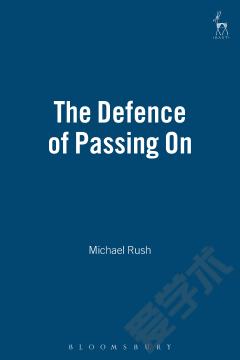The Defence of Passing On
1 Introduction A. Thematic Outline B. Chapter Summaries Part I The Foundations 2 Introduction to the Defence of Disimpoverishment A. Introduction B. Questions in Unjust Enrichment C. Definition D. Change of Name E. Another Problem with Pseudonyms F. Triggering the Defence of Disimpoverishment G. Assumptions H. Taxation Agents I. Burden of Proof J. Judicial Responses to Disimpoverishment K. Conclusion 3 Common Law Cases on the Defence of Disimpoverishment A. Introduction B. England C. Australia D. Canada E. United States of America F. Conclusion 4 Statutory Defence of Disimpoverishment A. Introduction B. The Defence of Unjust Enrichment C. Operation of the Unjust Enrichment Defence D. Recovery for Third Parties of Overpaid VAT E. Influence of European Jurisprudence F. Conclusion Part II 'At The Expense Of' 5 What Might 'At the Expense of 'Mean? A. Introduction B. Two Interpretations of 'at the Expense of ' C. The Meaning of 'Loss' D. Loss and Restitution E. The Meaning of 'From' F. Differences between 'From' and 'Loss' G. Conclusion H. Addendum 6 What do the Cases say 'At the Expense of 'Means? A. Introduction B. Situation 1: 'Gain' Exceeds 'Loss' at the Moment of Receipt C. Situation 2: 'Gain' Increases After Receipt D. Conclusion 7 What should 'at the Expense of 'Mean? A. Introduction B. The Problem Restated: The Status Quo Ante cannot be Restored C. Four Conceptions of What 'At the Expense of 'Means D. Whenever Loss and Gain Do Not Equate E. 'Gain' Exceeds 'Loss'at the Moment of Receipt F. 'Gain' Increases After Receipt G. Conclusion Part III Other Reasons to Reject or Accept the Defence of Disimpoverishment 8 Other Arguments for Accepting the Defence of Disimpoverishment A. Introduction B. False Bases for Accepting the Defence C. A Legitimate Basis for Rejecting the Defence D. Conclusion 9 Other Arguments for Rejecting the Defence of Disimpoverishment A. Introduction B. False Bases for Rejecting the Defence C. Potential Bases for Rejecting the Defence D. Three Reasons for Rejecting the Defence E. Conclusion Part IV Third Parties 10 Third Parties A. Introduction B. When Can an Action be Brought Against a Claimant? C. Class Actions D. Recovery of Overpaid Tax by a Third Party (from the Claimant) E. Conclusion 11 Conclusion A. The Problems Restated B. The Conclusions Reached C. Restatement
{{comment.content}}








 京公网安备 11010802027623号
京公网安备 11010802027623号